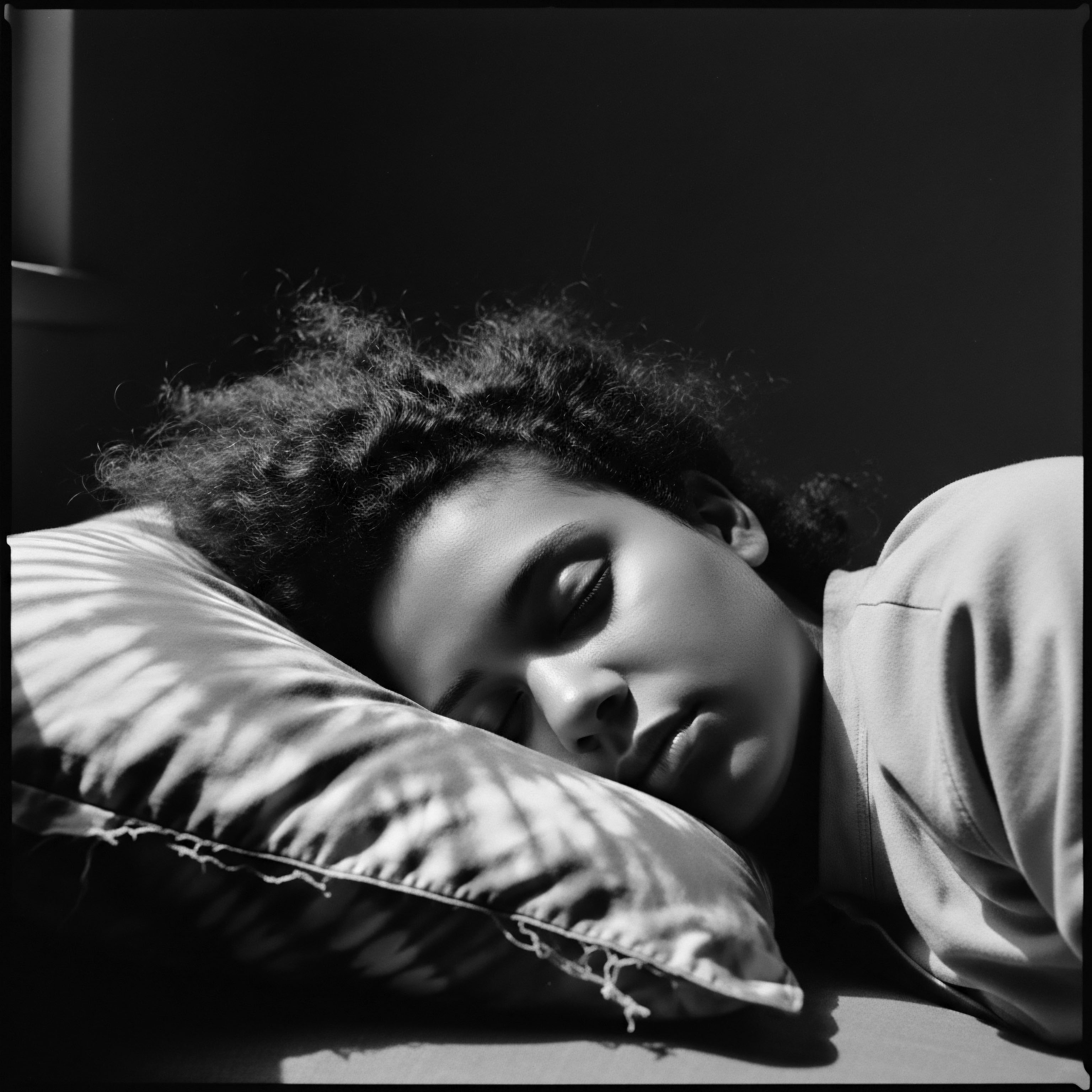
Fundamentals
The concept of the Hair Follicle Clock, at its most elemental level, speaks to the innate rhythm governing the life of each individual hair strand upon our scalp. It is an intricate biological timer, unseen yet ceaselessly at work, orchestrating the periodic shifts that allow our hair to grow, transition, rest, and ultimately release itself before a new strand emerges from the same follicular wellspring. This profound, cyclical process is a biological constant across all human beings, a testament to the elegant design embedded within our very cells.
It is this fundamental, pulsating rhythm that dictates not only the potential length a hair might attain but also the very density and vitality of our crowning glory. Each hair follicle acts as a miniature, independent arbiter of this cycle, ensuring a continuous, graceful turnover rather than a sudden, collective shedding.
Consider the ancient wisdom that observed nature’s enduring cycles—the moon’s phases, the ebb and flow of tides, the seasonal dance of planting and harvest. Long before microscopes revealed cellular intricacies, human communities intuitively grasped the cyclical nature of life, including that of their hair. Traditional societies, deeply connected to the pulse of the earth, understood that everything possessed a life span, a beginning, a middle, and an end, before renewal.
Hair, too, was seen through this lens, its vitality understood not as a static state, but as a dynamic unfolding. These early, communal understandings of hair’s natural progression shaped initial approaches to care, practices rooted in observing the hair’s inherent tendencies and working in concert with them, rather than against them.
The Hair Follicle Clock is the invisible, internal rhythm governing the life phases of each hair strand, guiding its growth, transition, rest, and renewal.
In many ancestral traditions, hair was regarded as a living extension of the self, a conduit to spiritual realms or a marker of lineage and status. This reverence naturally led to care practices that honored the hair’s own temporal existence. The understanding that hair would eventually shed, making way for new growth, was not met with dismay but often with acceptance, seen as a natural part of being.
Rituals surrounding hair, from daily grooming to rites of passage, implicitly acknowledged this biological clock, seeking to optimize its natural course, to soothe the scalp, and to provide the hair with the sustenance it needed for its journey. These practices were often interwoven with communal bonds, transforming personal care into a shared, intergenerational act of preservation and celebration.
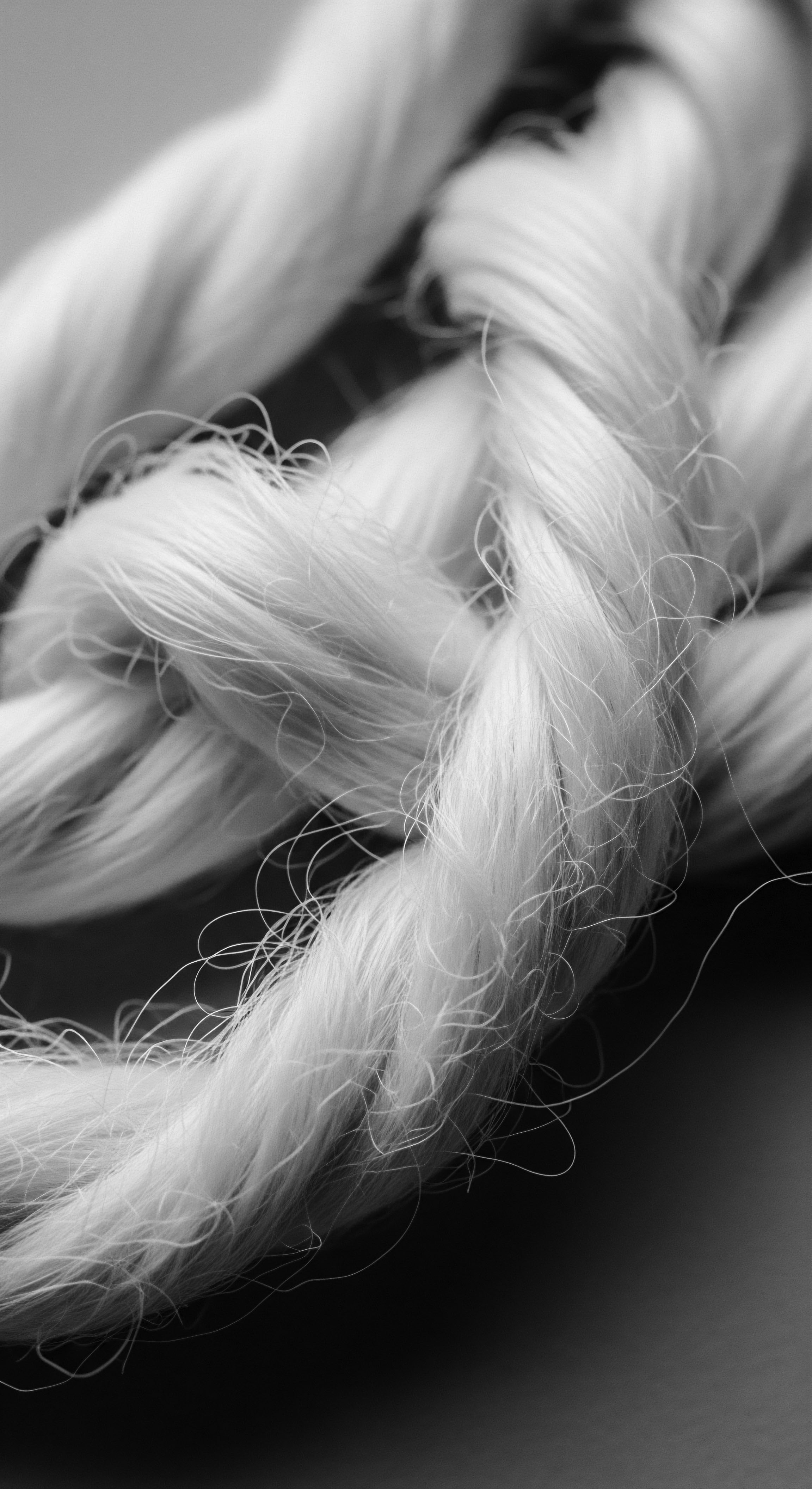
The Anagen Phase ❉ A Period of Flourishing
The inaugural act in the Hair Follicle Clock’s grand performance is the Anagen Phase, the period of active growth. During this stage, hair cells at the root divide with fervent energy, pushing the hair shaft upwards and outwards from the follicle. This is when a strand gains its length, a consistent extension of approximately half an inch each month for many individuals. For scalp hairs, this vital period typically spans several years, often ranging from two to seven years.
It is during anagen that the hair receives its nourishment, its strength, and its color, as melanin-producing cells are actively engaged within the hair bulb. The longer a hair follicle remains in this phase, the greater the potential for significant hair length to be achieved.
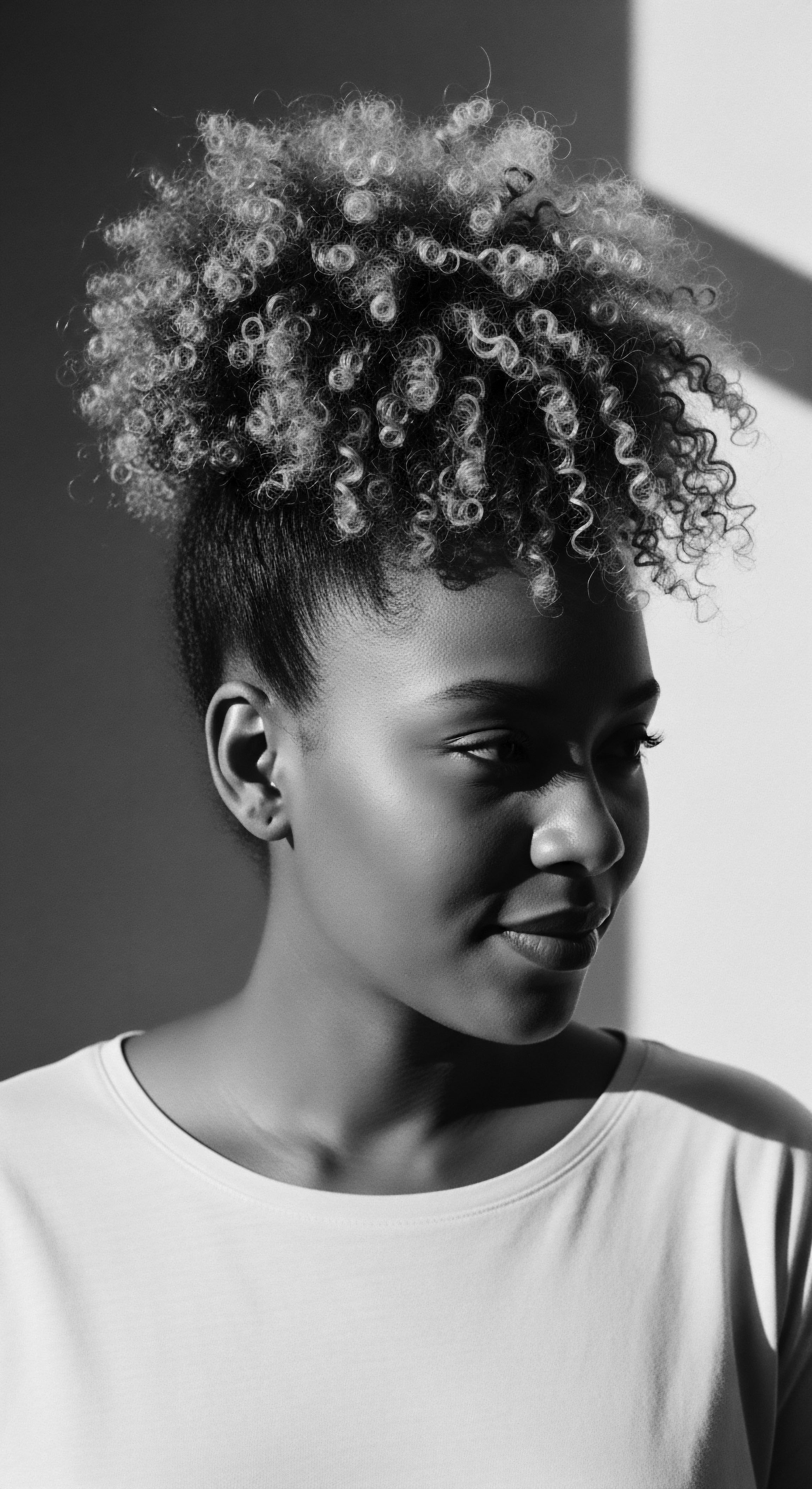
The Catagen Phase ❉ A Brief Transition
Following the anagen’s sustained momentum comes the Catagen Phase, a brief but crucial interlude. This transitional period, lasting approximately two to three weeks, signals a gentle winding down. The hair follicle shrinks, detaching itself from the dermal papilla, the source of its blood supply and essential nutrients. Cellular division ceases, and melanin production comes to a halt.
The hair strand, now a “club hair,” is prepared for its next inevitable journey. It is a moment of reflection within the follicular clock, a necessary pause before the deep rest that precedes renewal.

The Telogen and Exogen Phases ❉ Rest and Release
The final stage of the Hair Follicle Clock’s primary cycle is the Telogen Phase, a period of profound rest for the follicle. This stage, lasting usually two to four months, sees the club hair remain in place, though no longer actively growing. Beneath it, within the same follicle, a new hair often begins to form, subtly pushing the old one towards its release. The culminating moment is the Exogen Phase, the act of shedding.
This natural release of the old hair makes way for the vibrant new growth emerging from beneath. On average, a person might release between 50 and 100 strands of hair daily, a completely normal part of this continuous, rejuvenating cycle. This ongoing, independent rhythm of each follicle ensures that while some hairs are departing, others are actively growing, maintaining a relatively consistent density across the scalp.

Intermediate
Stepping beyond the fundamental understanding, the Hair Follicle Clock reveals itself as a sophisticated biological orchestration, sensitive to a multitude of internal and external influences. While the core phases of anagen, catagen, telogen, and exogen universally guide hair growth, the duration and efficiency of these phases are far from uniform across all individuals or populations. This variation forms the bedrock for understanding diverse hair characteristics and the evolution of care traditions that have acknowledged these inherent differences, often without explicit scientific articulation. The interplay of genetics, hormonal fluctuations, nutritional status, and even the environmental stressors an individual experiences can subtly recalibrate this internal timepiece, altering the potential for growth and the overall health of the hair.
For communities with a deep connection to textured hair heritage, the nuanced workings of the Hair Follicle Clock hold particular resonance. The natural tendencies of highly coiled and tightly curled strands, while fundamentally adhering to the universal growth cycle, manifest distinct considerations. The very structure of the hair follicle itself, which is often curvilinear for textured hair, influences the path of the hair shaft as it emerges, affecting its strength and susceptibility to breakage. This anatomical distinction, intrinsically linked to the Hair Follicle Clock’s rhythmic output, has profoundly shaped ancestral hair care practices and the communal wisdom passed down through generations.
The Hair Follicle Clock, while universal in its phases, exhibits unique expressions influenced by genetics, environment, and lifestyle, particularly within textured hair traditions.

Genetic Blueprints and Hair’s Unfolding Story
The blueprint for our Hair Follicle Clock is etched within our genetic code. These inherited predispositions significantly influence the length of our anagen phase, the diameter of our hair strands, and even the curl pattern that defines our hair’s character. For instance, studies indicate discernible differences in hair growth rates and fiber properties across various ethnic groups. African hair, with its characteristic tight coils, generally exhibits a slower growth rate compared to Asian or Caucasian hair, averaging around 0.9 Cm Per Month compared to 1.2 cm for Caucasian hair and 1.4 cm for Asian hair (Loussouarn et al.
2005; Keis et al. 2011). This biological reality, often linked to a genetically shorter anagen phase and a greater percentage of follicles in the resting state, means that achieving considerable length naturally presents a different journey for many with Afro-textured hair.

The Ancestral Response to Hair’s Rhythms
Ancestral communities, across continents and generations, developed ingenious methods to support the hair’s natural cycles. Their practices, honed over centuries, were not always consciously about manipulating the “Hair Follicle Clock” by name, but they intuitively fostered an environment where the hair could thrive within its genetic parameters. These traditions recognized the importance of gentle handling, moisture retention, and scalp nourishment, all of which directly or indirectly bolstered the Hair Follicle Clock’s healthy functioning.
- Scalp Massages and Circulation ❉ Regular scalp massages, a common ritual in many African and diasporic hair care traditions, stimulate blood flow to the hair follicles. This enhanced circulation delivers vital nutrients and oxygen, effectively supporting the anagen phase and promoting the production of robust, healthy hair cells.
- Protective Styling ❉ Techniques like braiding, twisting, and wrapping hair were not only forms of cultural expression but also practical solutions. These styles minimized manipulation and exposure to environmental stressors, reducing breakage and allowing hair to retain its length over longer periods, thus effectively supporting the Hair Follicle Clock’s work by preserving the hair shaft.
- Natural Oils and Butters ❉ The extensive use of plant-derived oils and butters, such as shea butter, coconut oil, and various herbal infusions, provided crucial moisture and lubrication to hair strands. This lessened friction, prevented dryness, and reduced mechanical damage, which is particularly vital for the more fragile nature of highly coiled hair that can be prone to breakage before its natural shedding cycle completes.
These time-honored practices speak to an embodied knowledge, a profound understanding of hair’s needs that transcends formal scientific language. They represent a harmonious collaboration with the Hair Follicle Clock, a recognition that while biology lays the groundwork, thoughtful, consistent care can optimize the hair’s inherent potential. The wisdom passed down through ancestral lines offered practical, hands-on strategies that fostered the hair’s well-being, allowing it to complete its growth journey with greater resilience.

Academic
The Hair Follicle Clock, from an academic vantage point, is not merely a descriptive term for the hair growth cycle; it represents a sophisticated, genetically encoded biological oscillator residing within the dermal papilla and surrounding follicular epithelial cells. This intrinsic timer dictates the precise temporal orchestration of cellular proliferation, differentiation, apoptosis, and quiescence that characterizes the anagen (growth), catagen (regression), telogen (rest), and exogen (shedding) phases. The clock’s intricate signaling pathways involve a complex interplay of growth factors, cytokines, hormones, and transcription factors, all meticulously regulated to ensure rhythmic hair regeneration. Disruptions to this delicate balance, whether genetically predetermined or environmentally induced, have profound implications for hair morphology, density, and overall scalp health.
For those examining textured hair heritage, the Hair Follicle Clock offers a critical lens through which to comprehend both the intrinsic characteristics of Afro-textured hair and the historical narratives surrounding its growth. While the fundamental machinery of the clock remains universal across all human populations, the nuanced calibration of its phases, particularly the duration of anagen, exhibits significant population-specific variations. This distinct calibration contributes meaningfully to the observable differences in hair length potential and density, challenging simplistic or often pejorative historical perceptions about textured hair’s capabilities.
The Hair Follicle Clock functions as a complex biological oscillator within the hair follicle, with its genetically influenced phase durations shaping the unique characteristics and growth potential of textured hair.

The Bio-Structural Realities and Heritage Narratives
Research indicates that Afro-textured hair, characterized by its elliptical cross-section and often profound curl patterns, grows at a rate demonstrably slower than other hair types. Quantitative studies have consistently shown that the average growth rate for African hair is approximately 0.9 Cm Per Month, substantially less than the 1.2 cm per month typical for Caucasian hair and the 1.4 cm per month observed for Asian hair (Loussouarn et al. 2005).
This measurable difference is intrinsically linked to the Hair Follicle Clock’s anagen phase. For many individuals of African descent, the anagen phase is genetically predisposed to be shorter, thereby limiting the maximum attainable length of the hair strand before it enters the transitional and resting phases.
Compounding this shorter growth period is the inherent structural vulnerability of highly coiled hair. The numerous twists and turns along the hair shaft create multiple points of fragility, making it more susceptible to mechanical damage and breakage (Davis-Sivasothy, 2011). This susceptibility means that for Afro-textured hair, the phenomenon of breakage often outpaces the rate of growth (Khumalo et al. 2000).
The hair, though actively growing from the root at a consistent rate according to its specific follicular clock, may fracture along its length before it reaches its genetic length potential. This leads to a persistent perception of stagnation or lack of growth, perpetuating a historical misconception that such hair “does not grow long,” when in truth, the Hair Follicle Clock is diligently at work, but the hair shaft is undergoing structural compromise. The ancestral care practices often implicitly understood this dynamic, focusing on protective measures and deep conditioning to minimize breakage and preserve the integrity of the growing strands.

Intersectional Impacts ❉ Socio-Historical Stressors and the Hair Follicle Clock
Beyond the inherent biological differences, the Hair Follicle Clock in textured hair communities has also navigated the profound impact of socio-historical stressors. The legacy of slavery and subsequent systemic oppression often forced hair practices that were detrimental to the natural Hair Follicle Clock. The pressure to conform to Eurocentric beauty standards led to the widespread use of harsh chemical relaxers and tight, tension-inducing styles. These practices, while attempting to alter the hair’s natural form, inadvertently placed immense strain on the hair follicle, leading to inflammation, damage, and in many cases, permanent hair loss conditions like Central Centrifugal Cicatricial Alopecia (CCCA) (Callender et al.
2013). This chronic inflammation and mechanical stress can effectively disrupt the Hair Follicle Clock, prematurely pushing follicles into catagen or telogen, or even leading to their irreversible scarring and dormancy.
The resilience observed in the Hair Follicle Clock amidst such adversity speaks to the deep biological robustness of the human system, yet also highlights the need for a culturally informed understanding of hair health. The very act of reclaiming traditional hair care practices—those rooted in gentle handling, natural ingredients, and low-tension styling—can be viewed as a conscious act of re-aligning with the hair’s natural clock, allowing it to function optimally within its inherent design. This re-alignment is not merely a superficial aesthetic choice; it is a profound act of self-preservation and ancestral honoring, recognizing the biological wisdom that informed historical care.
Consider the profound significance of community-based hair rituals in mitigating these stresses. The shared act of braiding, oiling, and nurturing hair within families and communities provided not only physical care but also psychological solace. These moments, often laden with storytelling and intergenerational teaching, served as a buffer against the external pressures to deny one’s hair’s natural inclination. In essence, while the Hair Follicle Clock continued its biological rhythm, these communal practices offered a protective ecosystem, promoting an environment where hair could thrive despite challenging circumstances.
| Characteristic Typical Growth Rate (cm/month) |
| African Hair 0.9 |
| Caucasian Hair 1.2 |
| Asian Hair 1.4 |
| Characteristic Hair Diameter (µm) |
| African Hair 55 (finest) |
| Caucasian Hair 65 (medium) |
| Asian Hair 70 (thickest) |
| Characteristic Cross-Sectional Shape |
| African Hair Flattened, Elliptical |
| Caucasian Hair Elliptical |
| Asian Hair Round, Uniform |
| Characteristic Anagen Phase Duration |
| African Hair Often shorter |
| Caucasian Hair Intermediate |
| Asian Hair Often longer |
| Characteristic Susceptibility to Breakage |
| African Hair Higher, due to structural fragility |
| Caucasian Hair Medium |
| Asian Hair Lower |
| Characteristic Shed Hair Observations |
| African Hair Often shorter, no proximal club (suggests breakage) |
| Caucasian Hair Full-length with telogen club (natural shedding) |
| Asian Hair Full-length with telogen club (natural shedding) |
| Characteristic This table highlights how the inherent biological characteristics, influenced by the Hair Follicle Clock's variations across ancestries, necessitated distinct historical and contemporary care practices within textured hair communities. |
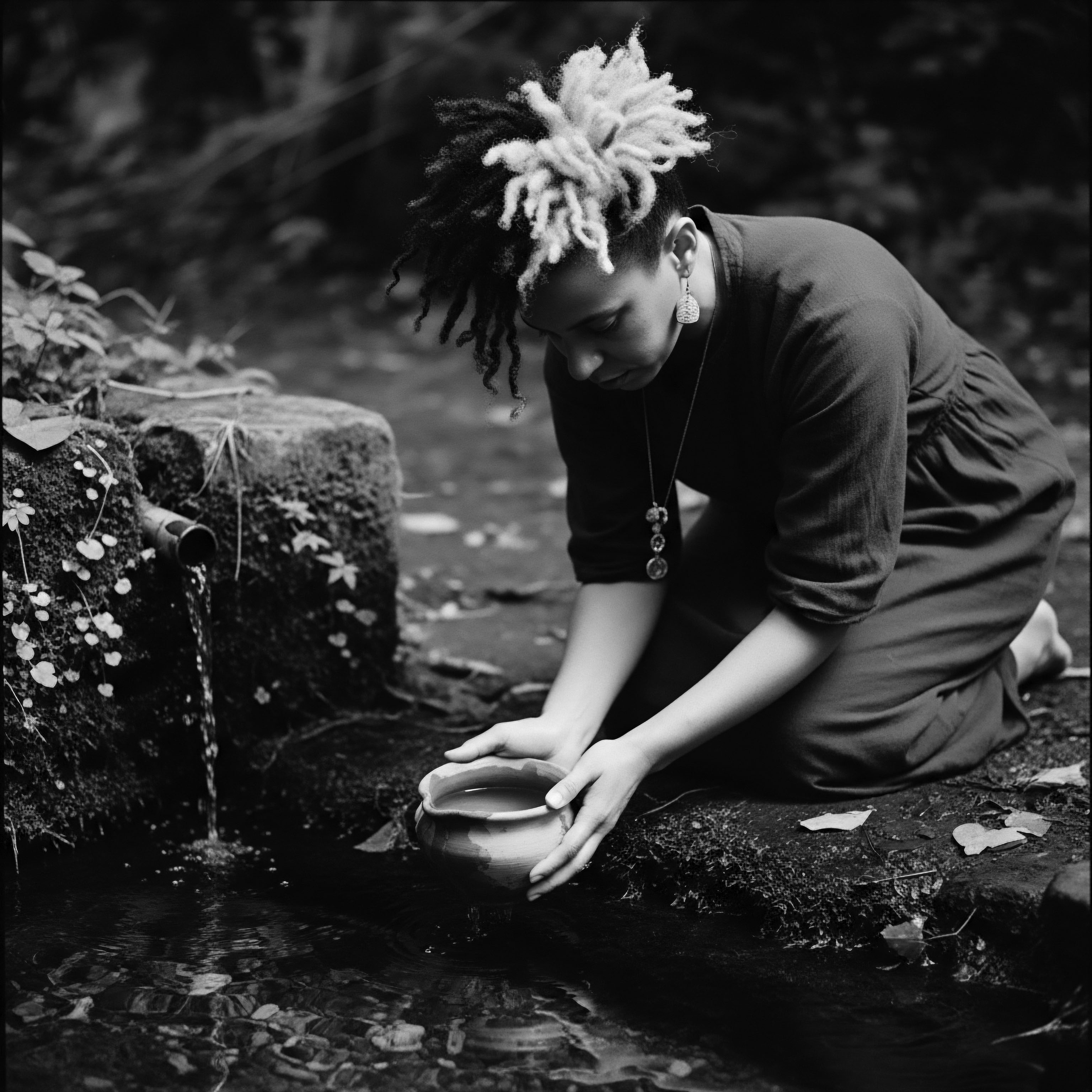
The Pharmacogenomics of Hair and Ancestral Adaptation
Delving deeper into the academic discourse, the Hair Follicle Clock’s regulation is increasingly understood through the lens of pharmacogenomics and molecular biology. Genetic variations (single nucleotide polymorphisms or SNPs) within genes that regulate follicular stem cell activity, melanin synthesis, and structural protein formation can subtly yet significantly alter the anagen duration and hair fiber properties. For instance, variations in genes like WNT10A have been linked to tightly coiled hair phenotypes and shorter anagen hair syndromes (Fujimoto et al.
2018). This underscores that the Hair Follicle Clock is not an isolated phenomenon, but rather a manifestation of complex genomic interactions, which in turn inform the unique expressions of hair across diverse populations.
The historical reliance on certain plant extracts and natural compounds in ancestral hair care, while not scientifically validated at the time, represents an intuitive pharmacogenomics. Many traditional ingredients, such as certain essential oils or botanical extracts, possess anti-inflammatory, antimicrobial, or antioxidant properties that could theoretically support a healthy scalp microenvironment, thus indirectly bolstering the Hair Follicle Clock. While direct evidence linking specific traditional African botanical compounds to anagen prolongation is still emerging in contemporary research, the historical efficacy observed through generations suggests a form of empirical knowledge that worked in concert with the hair’s biological rhythm.
The very act of massaging the scalp with these infusions, a practice widely documented, further enhanced circulation, a known physiological stimulus for follicular activity. This historical wisdom, accumulated through repeated observation and practice, served as an ancestral form of personalized medicine, tailored to the unique expression of the Hair Follicle Clock within those communities.
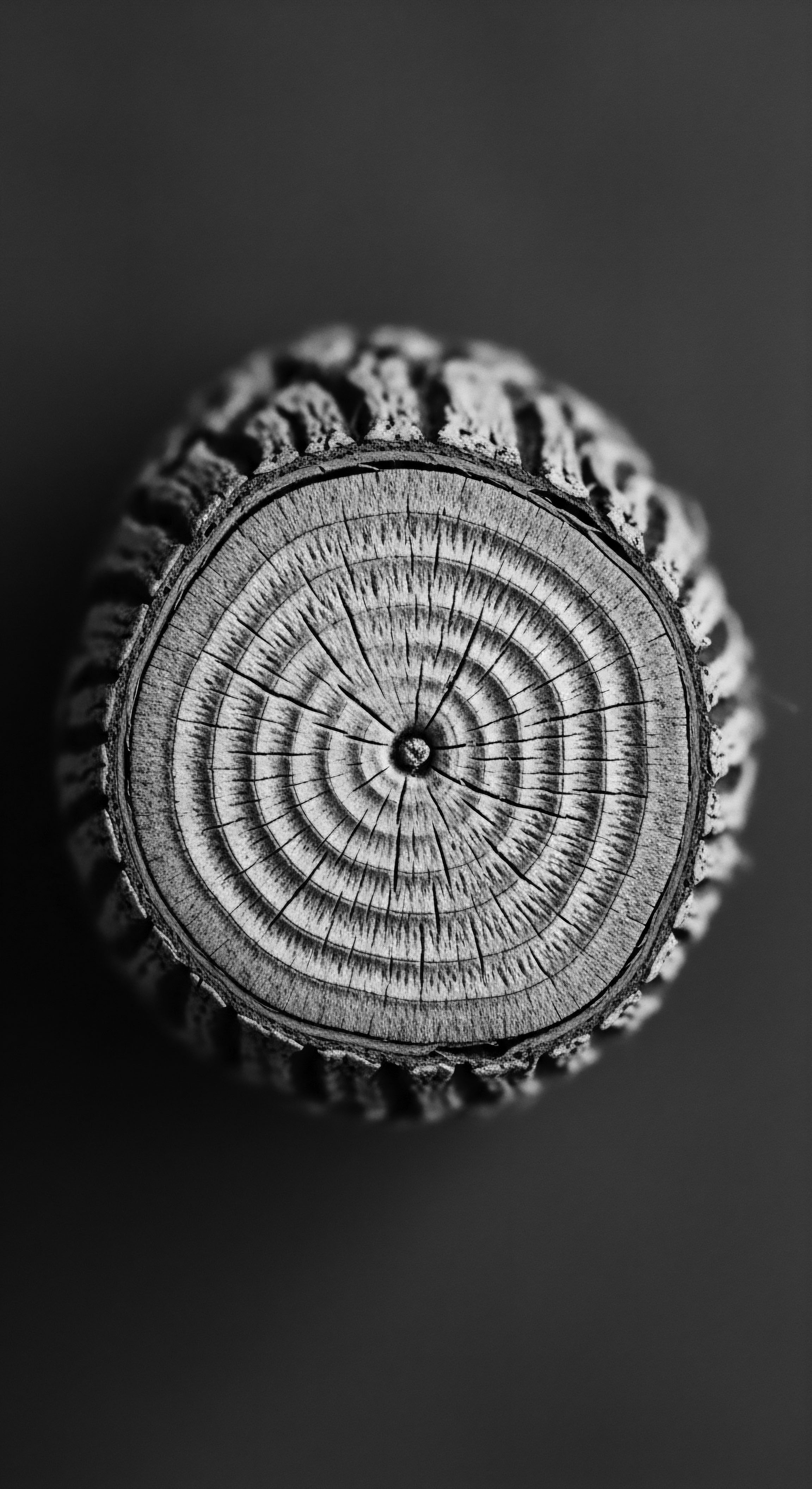
Reflection on the Heritage of Hair Follicle Clock
As we gaze upon the intricate dance of the Hair Follicle Clock, we witness more than a mere biological process; we behold a living testament to resilience, a continuum connecting elemental biology to the enduring legacy of textured hair heritage. The strands that crown us carry not only genetic information but also echoes of ancestral wisdom, whispers of hands that meticulously cared for hair through trials and triumphs. The Hair Follicle Clock, with its unique rhythmic expressions in textured hair, reveals that every curl, every coil, is a vibrant thread in a much grander, intergenerational narrative of adaptation and enduring beauty.
Understanding this inner timing mechanism, especially within the context of Black and mixed-race hair experiences, transforms our perspective. It invites us to move beyond superficial judgments or historical misconceptions about hair length and growth, urging us instead to appreciate the profound intelligence embedded in our very being. The wisdom held within ancestral practices—the gentle touch, the nourishing oils, the communal braiding circles—was, in essence, a sophisticated dialogue with the Hair Follicle Clock, an intuitive honoring of its cycles and an adaptive response to its unique needs.
The journey of the Hair Follicle Clock, from its elemental biological source through the tender threads of care and community, ultimately shapes an unbound helix of identity. It reminds us that our hair is a vibrant archive, capable of voicing stories of heritage, resilience, and unapologetic selfhood. In embracing the nuances of our Hair Follicle Clock, we connect with a lineage of profound knowledge, affirming that caring for our hair is an act of deep reverence, a perpetual honoring of the vibrant lives that have shaped our present. It is a harmonious return to the source, affirming the living legacy woven into every strand.
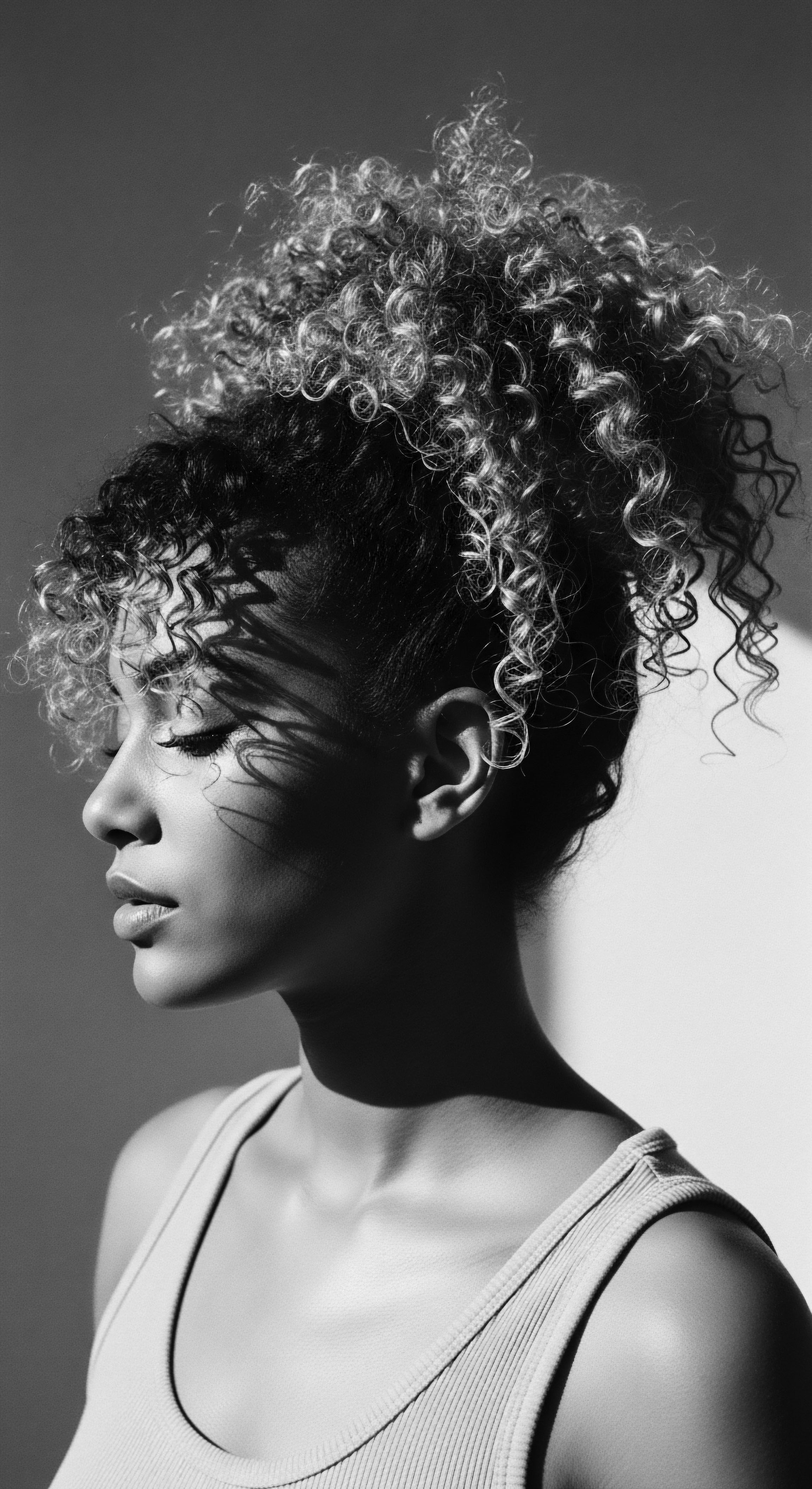
References
- Byrd, A. & Tharps, L. D. (2001). Hair Story ❉ Untangling the Roots of Black Hair in America. St. Martin’s Press.
- Callender, V. D. Wright, D. R. & McMichael, A. J. (2013). Hair and Scalp Diseases in Ethnic Minorities. CRC Press.
- Davis-Sivasothy, A. (2011). The Science of Black Hair ❉ A Comprehensive Guide to Textured Hair. Sivasothy Publishing.
- Fujimoto, A. Kariya, N. Tanemura, A. Hattori, T. & Takehana, M. (2018). Genetic analysis of Woolly Hair Syndrome and Short Anagen Hair Syndrome. Journal of Investigative Dermatology, 138(5), 1085-1093.
- Keis, K. Krome, K. & Wortmann, G. (2011). Hair structure and properties of different ethnic groups. Journal of Cosmetic Science, 62(5), 455-472.
- Khumalo, N. P. Gumedze, F. & Thami, G. P. (2000). African Hair ❉ A review of the growth, structure, and diseases. Journal of the American Academy of Dermatology, 43(3), 481-489.
- Loussouarn, G. Quatresooz, P. & Doutre, M. (2005). Diversity in human hair growth, diameter, colour and shape. An in vivo study on young adults from 24 different ethnic groups observed in the five continents. Skin Research and Technology, 11(3), 195-209.
- Sperling, L. C. & Cowper, S. E. (2006). Hair and Scalp Diseases ❉ Medical and Surgical Approaches (2nd ed.). Informa Healthcare.
